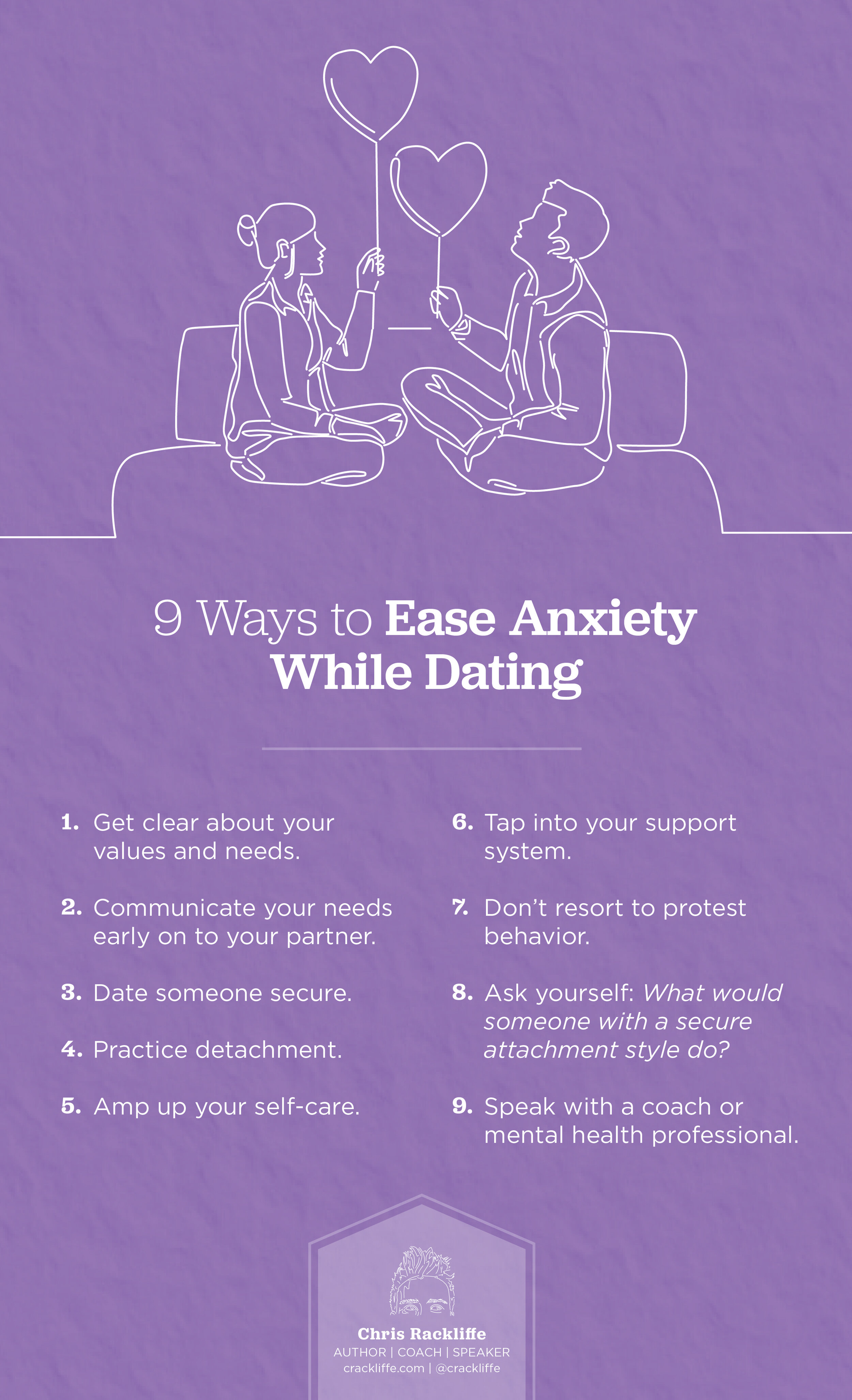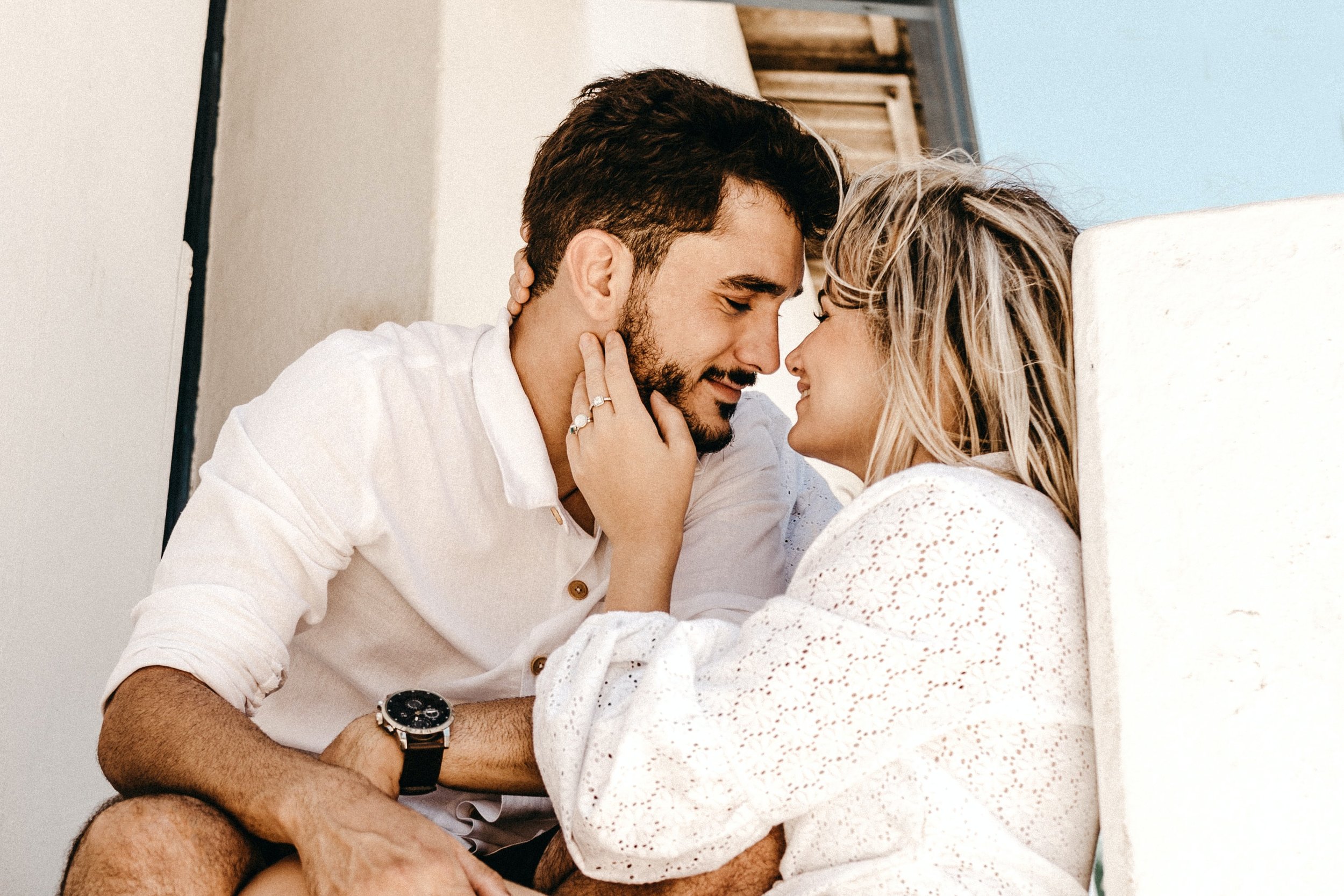9 Ways to Ease Anxiety While Dating

I hadn’t heard from him in four days, and my mind was at war with itself.
Negative thoughts were running rampant. Cognitive distortions were tripping me up left and right. I felt overwhelmed with emotion and under siege with worry.
Is he ghosting me? I wondered. I’ll probably never hear from him again, I thought. It’s definitely over, I assumed.
Or at least that’s what it felt like at the time.
In reality, I knew there must be a way out of this spiral—some solution to pull me out of the depths of doubt. I closed my eyes and sat with my discomfort. I turned my focus inward and brought my attention to my breath. The rise and fall of my chest superseded the racing thoughts in my mind. I surrendered.
My nervous system slowed down as a sense of relief washed over me. You are safe, I said to the little one inside. No matter what happens, you are safe here.
When my anxiety kicks into overdrive, my pulse quickens and my breathing becomes shallow. My body clenches and I feel tense. I become one giant ball of stress. All it takes is a simple trigger: An unfavorable reaction, an awkward pause in conversation, or perhaps, as in this case, no response at all. Then the doubts creep in—and take over.
This description likely sounds all too familiar to those who struggle with anxiety. Dating and relationships can feel excruciating when you get triggered and fall into what seems like an endless pit of stress and worry.
But it doesn’t have to be this way. You can find new ways to cope. You can calm your nervous system down. You can develop a toolkit to help you self-soothe.
At least that’s what I did when I felt my anxiety creep in after the guy I was dating went radio silent for several days. While that situation fizzled out shortly after he resurfaced, it helped me realize something profound: I have a power that no external event can take away—access to a well of inner peace.
And I’m the only one with the key.
Grab a copy of my new book, Needy No More: The Journey From Anxious to Secure Attachment.
Below, I outline nine ways you can reclaim this same inner peace for yourself. Whether you’re single or already in a relationship, I know these tips have the power to transform your life. Because they transformed mine.
First, let’s explore what it looks like to have anxiety that specifically stems from your romantic relationships.
What does it mean to have an anxious attachment style?
One of the best ways to tackle your relationship-related anxiety is to know what attachment theory is, and what having an anxious attachment style means.
A branch of psychology that originated in the 1950s and 60s from research conducted by John Bowlby and Mary Ainsworth, attachment theory puts forth a framework for understanding how individuals build lasting emotional connections with others based on their upbringing and relationships with their caregivers. Based on decades of research, psychologists have identified four primary attachment styles:
Secure attachment style: Someone with a secure attachment style feels inherently safe and secure in their emotional connections with others. These folks enjoy a healthy degree of intimacy and are naturally warm and loving in their relationships, effectively communicating their needs and feelings. The fundamental belief behind a secure attachment style is: I am worthy and capable of deep love.
Avoidant attachment style: Someone with an avoidant attachment style values independence and self-sufficiency above all else, often preferring to “go it alone” rather than risk giving up a sense of personal freedom for the sake of a relationship. When a person with an avoidant attachment style does find themselves in a relationship, they are often emotionally distant, as too much intimacy can be triggering to them and make them feel like they need space. The fundamental belief behind an avoidant attachment style is: I don’t need anyone; people always try to take away my freedom.
Anxious attachment style: Someone with an anxious attachment style craves emotional intimacy above all else, often desiring to “become one” with their romantic partners. People who possess an anxious attachment style tend to over-identify with and obsess over their relationships, becoming preoccupied with the emotional availability of their love interests. As someone extremely sensitive to their partner’s moods and reactions, dating can often feel like a roller coaster of emotions, with many highs and lows that are dependent upon the person they’re seeing. But, with consistent communication over time, folks with an anxious attachment style can come to feel secure in their romantic relationships and develop lasting partnerships that are supportive and healing. The fundamental belief behind an anxious attachment style is: No one wants to connect with me as deeply as I do; I always get left in the end.
Anxious-avoidant attachment style: Someone with an anxious-avoidant attachment style craves both closeness and space, oftentimes oscillating between these opposing needs from day to day or even hour to hour. The least common of all the attachment styles as well as the most volatile and painful, having this combination of the anxious attachment style and avoidant attachment style can still be addressed. In order to grow more secure, this person will need to learn to identify their needs and clearly communicate about them despite their fears of both intimacy and abandonment. The fundamental belief behind an anxious-avoidant attachment style is: I can’t trust myself to open up and I can trust that others won’t leave. I struggle to find a relationship where I can really be myself. [Note: this attachment style also goes by fearful-avoidant attachment style and disorganized attachment style.]
Here are some indicators that you may have an anxious attachment style:
You’re sensitive and hyper-vigilant to any emotional unavailability
You crave closeness
You need lots of reassurance
You constantly think your partner will leave you or that you’ll be abandoned
Read my blogs: 7 Ways to Heal the Anxious Attachment Style, 5 Ways to Heal a Fear of Abandonment, 8 Books for Healing Anxious Attachment, 4 Breakup Tips for Anxious Attachers, The Anxious Attacher’s Guide to Setting Boundaries, and 7 Conflict Resolution Techniques That Can Save Your Relationships.
You’re full of worry and doubt about your relationship, especially in the early stages
You’re jealous
You’re controlling
You’re often worried about infidelity
You tend to act out, doing or saying things that you later regret
In the spirit of better getting to know yourself and what it is that you need in a relationship, consider taking an attachment style test to evaluate where you stand on the attachment spectrum. Keep in mind that different attachment style quizzes may use slightly different terminology to describe each attachment style, such as using the terms anxious, ambivalent, and preoccupied interchangeably. If you happen to have an anxious or ambivalent or preoccupied attachment style, I also highly recommend doing more reading and research to become more acquainted with the meaning of your attachment style. For example, my therapist recommended that I read Attached: The New Science of Adult Attachment and How It Can Help You Find—and Keep—Love, and it completely blew my mind.
One of the 13 books that changed my life and 9 books that changed my love life, I found Attached to be a powerful introductory guide to attachment theory for two reasons. First and foremost, if you have an anxious attachment style, reading this book will be like seeing all of your past intimate relationships printed in black ink on white paper. When I was reading Attached I felt truly seen and understood. In addition, Attached will completely transform the way you look at what you need in a romantic partner, and, more importantly, where those needs originate—for instance, with your primary caregivers. You simply can’t underestimate the power of knowing that the way you feel is natural and actually a common reaction among a certain set of people.
The big takeaway? You’re not needy just because your needs are different from those of your partner. There’s no shame in admitting what makes you feel appreciated, valued, and respected in a relationship—and that you may need to see and hear and feel those things more often than the person you’re seeing.
It’s about time you owned it.
Are you looking for ongoing support with your anxious attachment style? If so, join my new FREE support community on Facebook.
9 Ways to Ease Anxiety While Dating
1. Get clear about your values and needs.
What exactly do you need from a partner or in a relationship? If you’re struggling to answer that question, it’s time to get some much-needed clarity.
Start by thinking back on your prior relationships. Make a list of all those things for which you’ve criticized your previous partners. Then reflect on that list through the lens of unmet needs. We tend to get upset with our romantic partners where we are most vulnerable and where our needs are greatest. For example, if you criticized a former dating partner for not appreciating you, perhaps you need to feel cherished, or at least hear affirming things from them.
In addition to unmet needs, look for patterns across multiple relationships that haven’t served you well, such as dating several partners long-distance or dating someone who isn’t a strong communicator. These are signposts that tell you what’s working and not working—and what you need and don’t need in a partner.
If you’re not familiar with the five love languages, they may also be a helpful tool for better understanding your needs. Stemming from a book of the same name by Dr. Gary Chapman, the five love languages are five singular areas through which we give and receive love. Here are the five love languages at a quick glance:
Words of affirmation: Building the other person up through compliments and other verbal reminders
Quality time: Giving someone your undivided attention and spending time with that person
Physical touch: Demonstrating that you care through varying degrees of physical intimacy
Acts of service: Doing something on behalf of the other person that you know they’ll appreciate
Gifts: Whether big or small, buying something thoughtful for the other person
Consider taking a quiz to discover your own preferred love languages.
Regardless of the answers that appear, getting clarity about your needs is a powerful first step to ensuring that you find a partner who can meet those needs. And support your happiness in the process.
2. Communicate your needs early on to your partner.
If you have an anxious attachment style, this may not come intuitively to you, but the earlier and more clearly you can communicate your needs to your partner, the more likely you are to get those needs met—and the more likely you are to weed out those people who simply won’t be able to meet those needs in the first place.
Let them know how important communication is to you. See if they step up.
Let them know you like compliments and reassurance. Look for their follow through.
Let them know you’d like to know when you’re going to see them next. Take note of how they respond.
This isn’t about testing your partner, it’s about communicating what’s important to you and what makes you feel secure, and seeing if they care enough to make the effort.
I love the way the authors put it in Attached: “The more attuned you are to your partner’s needs at the early stages—and he or she to yours—the less energy you will need to expend attending to him or her later.” Get it out in the open. Ask questions about the needs of the person you’re dating and let them in on yours, too.
You’ll save yourself a lot of anxiety and worry in the long run if you do this.
3. Date someone (more) secure.
One of the biggest mistakes that someone with an anxious attachment style can make is to continue dating people that only exacerbate their anxiety. One particularly challenging dynamic that often repeats itself throughout the dating histories of many folks with an anxious attachment style is called the Anxious-Avoidant Trap. As it sounds, the Anxious-Avoidant Trap occurs when someone with an anxious attachment style becomes paired with someone with an avoidant attachment style.
Excited about the prospect of finding someone new who won’t try to control them, the avoidant person opens up and grows vulnerable with the anxious person, who is thrilled by the immediate attraction and intimacy offered by the avoidant individual.
Sparks fly.
In time, though, the avoidant person withdraws in order to cope, which triggers the hypersensitive anxious person to ask for reassurance and seek to restore closeness. This hyper-vigilance triggers the avoidant partner to withdraw further. Before they know it, the pair are trapped in a dynamic that only intensifies the triggers in one another.
While both the anxious and avoidant partners fall on the insecure end of the attachment spectrum, their needs are opposite. Individuals with an avoidant attachment style need a lot of space and autonomy. This need is scary to an individual with an anxious attachment style. Those who have an anxious attachment style need a lot of closeness and reassurance. These needs are scary to an individual with an avoidant attachment style. In the end, these competing needs create a roller coaster of highs and lows—pulling closer and pushing apart—that feel crushing to the person with an anxious attachment style.
Neither partner is happy or fulfilled in this type of relationship.
If you have an anxious attachment style, please read what I’m about to say slowly and intently, taking in each word: You are far better off dating someone who is not only able but actually willing to meet your emotional needs. That doesn’t mean that a relationship absolutely can’t work between partners who are anxious and avoidant. However, it will take a significant amount of effort in the form of communication and compassion to make it work. And when it comes to compromise, the anxious person is typically the one to bend.
Do yourself a favor and find someone who has enough self-awareness and done enough self-work to be able to give you the closeness and reassurance you crave—regardless of their attachment style. While labels are limiting, I find it helpful to look at how well the person knows their style of relating to others and see if they’ve done anything to address it. In the end, growing more emotionally secure is a lifelong goal, but you certainly want to connect with someone who’s on the path to get there to begin with.
It’s not impossible. That person is emotionally available and hoping to meet you.
Let the dysfunction go.
Don’t just find someone secure, become someone secure. My Anxious Attachment Style Healing Toolkit can help.
4. Practice detachment.
There’s no better way to pull yourself out of attachment overdrive than by practicing its opposite: Detachment. As someone with an anxious attachment style, regardless of what your partner is like, you likely spend a lot of time ruminating about things that are completely out of your control, such as what the future of your relationship might be. When your attachment system is triggered, you become overcome with fear and it feels almost impossible to let go. That’s exactly what detachment offers us—the ability to be emotionally present but removed enough to not try to control the outcome. The key is to bring the focus back to you—back to what’s under your control—so you stay grounded and don’t feel like you’ve lost your way.
In Codependent No More: How to Stop Controlling Others and Start Caring for Yourself, Melody Beattie writes:
“Detachment is based on the premises that each person is responsible for himself, that we can’t solve problems that aren’t ours to solve, and that worrying doesn’t help… Detachment involves ‘present moment living’—living in the here and now. We allow life to happen instead of forcing and trying to control it. We relinquish regrets over the past and fears about the future. We make the most of each day.”
For someone with an anxious attachment style—someone who often feels they are in danger of being left or abandoned—this can feel like a daunting task. (As Beattie goes on to write: “You need to detach most when it seems the least likely or possible thing to do.”) Truthfully, this process is simple and straightforward. Learn to observe your emotions. Recognize that the reaction you’re having is a natural one with origins in the past, not the present. Take accountability for the fact that your triggers are just that—yours. You are ultimately responsible for whether or not you act on them. Lean on your faith and believe that what’s happening is for your benefit. Try repeating some of these affirmations to remind yourself that you’re not actually in crisis, it just feels that way:
The way someone else treats me is a reflection of their character and not mine
I trust that things will work out for the best no matter what happens
I am not taking that on today
I am capable of letting it be
I am okay with whatever happens today
What is meant for me won’t pass me by
5. Amp up your self-care.
Self-care is an immediate way to bring the focus back to yourself when you’re anxious about what’s going on around you or in your relationship. It’s also replenishing because you’re investing time to take better care of yourself, meet your own needs, and regulate your nervous system. Here are some ways you can do just that:
Meditate: Just like I did in the opening story, carve out some time to close your eyes, breathe deeply, and simply notice and allow what you’re experiencing emotionally and physically to occur. Personally, I prefer to meditate before bed, but you can do so any time throughout the day when you’re feeling anxious, fearful, or overwhelmed. Try out some guided meditations on YouTube, or check out apps like Calm or Headspace, which are dedicated to meditation, or Peloton, which has hundreds of guided meditations as well. As a cherry on top, research has shown that meditation provides myriad health benefits in addition to helping you manage stress and anxiety. Score!
Talk to your inner child: While meditating or relaxing, think about this prompt: What does my inner child need to hear right now? All of us have a scared little one inside. Part of self-soothing means sitting with the part of ourselves that’s anxious and afraid and comforting it like we would an actual person. So give that little one a verbal or metaphorical hug. You might need it more than you realize.
Exercise: That’s right—sweat it out! Whether it’s a walk around your neighborhood, a quick workout at home, or a full-on gym session, exercise is a natural way to boost your mood. The endorphins that are released from exercise help to reduce the stress that accompanies anxiety—and calm your nervous system down in the process.
Write about how you’re feeling: One of the most cathartic and cleansing things you can do when thoughts of doubt are swirling uncontrollably in your mind is to get them all down on pen and paper. By writing about how you feel, you can actually empty your mind of the negative thoughts, and detach from your identification with them. Give it a go and see how it works for you.
Challenge your thoughts: Once you get your thoughts out of your head and written on paper, learn to challenge them. Question their validity. Learn to recognize their absurdity and irrationality. Read them as if a friend had shown you the same piece of writing. Give yourself the compassion you need to self-soothe.
Get creative: Whether it’s writing, drawing, painting, coloring, singing, or something else entirely, get those creative juices flowing. Focusing on a creative project can be a fun and freeing endeavor that will help you feel lighter, calmer, and more productive, too. The next time you’re feeling anxious, get creative instead. It’ll help you get your mind off of things.
6. Tap into your support system.
When self-reflection and self-care aren’t enough to relieve your anxiety, try talking with a close friend or loved one about how you feel. When someone lends an ear when we’re in need, it’s beneficial for both parties. It allows you to get things out of your mind and off your chest, and it allows them to show their support and compassion for you. Talk about a win-win!
Go ahead and call that friend or relative. Vent about your worries. Let off some steam. Get their perspective on things.
It may just help lighten your load.
Want more relationship advice? Read my blog, 18 Essential Truths for Healthier Relationships!
7. Don’t resort to protest behavior.
In Attached, Dr. Amir Levine, M.D. and Rachel S. F. Heller, M.A. define protest behavior as acting out by “letting your attachment system get the best of you.” What does that mean? It might look like these examples, which are further outlined in the book:
Excessive attempts to reestablish contact
Withdrawing
Keeping score
Acting hostile
Threatening to leave
Manipulation
Making your partner feel jealous
In the end, these are all indirect ways to try to get your emotional needs met. The key is to shift to a calmer, more direct method such as effectively communicating with your partner about how you feel and what you need. Many folks with an anxious attachment style find this task daunting because they do not want to overwhelm or scare away their partner. What they don’t realize, though, is that by not asking for what they need, they are very often the cause of not having those needs met. In short, you’ll never get what you don’t have the courage to ask for.
Instead of acting out with protest behavior, muster up the courage to ask for what it is that you truly want. Try following these assertive communication strategies:
Objectively identify what you observed
Communicate how it made you feel
Make a request
Use “I” statements, not “you” statements
Maintain an even tone of voice—do not yell, get angry, or speak over the other person
Here’s an example based on the lack of response I experienced in the opening story:
Hi there! I noticed that I haven’t heard from you over the past few days. I just wanted to be fully transparent that I feel anxious and out of the loop when we go several days without speaking. Are you free this evening to catch up over the phone? It would mean a lot to me.
See, it’s possible to communicate without attacking or criticizing while also explaining how it makes you feel. Give it a try and see how your partner responds.
8. Ask yourself this question.
One of the most powerful things you can do when you are in the middle of an intense period of anxiety stemming from your romantic life is to ask yourself this question: What would someone with a secure attachment style do? Reframing your experience in this way is like hitting a reset button. Instead of indulging your anxiety and acting on your fears, you can consciously consider how you or someone you know would behave if you—or they—felt secure in the same situation.
For this reason, whether it’s an individual or a couple, it may be helpful to identify a secure role model to look to when your attachment system is triggered and you feel anxious. How would they behave? Remember, this isn’t about acting out in protest behavior but rather about getting your needs met. Focus on ways you can do that without using your anxiety as a guide.
9. Speak with a professional.
If the tips above don’t offer enough relief or you’d like to go deeper in your self-exploration, it might be worthwhile to explore talking to a therapist, mental health professional, or coach. Remember, while it’s important to be able to self-soothe, if your anxiety reaches a level that becomes unmanageable or a hindrance in your day to day life, you may want to consider other options. A psychologist, psychiatrist, or coach will help you do just that.
For even more wisdom on love and relationships, check out 14 Lessons in Love I Wish I’d Learned Sooner.
Become secure in your relationships
Tired of feeling taken for granted, wondering if your partner appreciates you, and second-guessing yourself when it comes to relationships?
I was, too.
I spent nearly a decade of my life dating the same emotionally unavailable type again and again and again. I remember picking up my phone dozens of times a day hoping to hear from them, only to be let down once more. I dated long-distance—not just once or twice but on more than a handful of occasions. I spent most of my 20s on this emotional roller coaster, wondering if I’d ever meet someone who truly wanted to be as close and connected as I did.
But then something changed.
I was tired of giving more than I was getting. I was emotionally drained. I decided that enough was enough.
Learning about my attachment style was a watershed moment for me.
For many years, I thought I was crazy for feeling like I wanted to be closer to my partner or because I needed more reassurance than most. I was deeply ashamed of coming across as “clingy,” “smothering,” or “needy.” Worst of all, I self-sabotaged by not acknowledging that my needs were valid and that I was worthy of having those needs met.
I bet you feel the same. If any of the below scenarios resonate with you, you’re not alone. Have you:
Obsessed over every move made or message sent by someone you were dating
Lost sleep worrying if they’ll leave you
Lashed out when you feel slighted or ignored
Craved constant reassurance and compliments
Stalked your dating prospects on social media—sometimes until the early hours of the morning
Felt like you lost yourself in a relationship
Resented dating partners for not meeting your expectations
Manipulated and controlled others to get your needs met
Fallen for someone really quickly, only for things to end just as fast
Felt completely consumed by fear of abandonment
I know what it’s like to struggle with an anxious attachment style. This was my life for many years until I put my foot down and made a decision that the old ways just weren’t serving me anymore.
If you’re ready to do the same, I’m here to help. I’ve seen many clients go from completely preoccupied with their relationship and overcome with anxiety to feeling at peace with themselves and their relationships.
Take Kelsey for example. She was in an unhealthy relationship that was no longer serving her, and she was riddled with doubt and anxiety that was spilling over into every other aspect of her life. In just four sessions of working with me, Kelsey:
Found the courage to break up with the guy that was clearly not right for her
Decided to move to a new city
Landed a promotion at work
Shifted her mindset
Grew more secure with what she had to offer a guy
Her life is vastly different than it was before we started working together! She did the work and transformed her life. It was amazing to witness.
I’m happy to report that Kelsey is in a new relationship—one that’s healthy with a partner who adores her. Kelsey finally got her groove back. Here’s what Kelsey had to say about working together:
“I learned to take the power back in my life. My thinking shifted from, ‘Why does this keep happening to me?’ to ‘Does this person fit what I’m looking for and my needs?’”
While Kelsey’s anxiety didn’t go away, she completely changed her relationship with it. With me as her coach, Kelsey learned how to self-soothe, techniques for identifying her triggers, what to look for in a new partner, healthy ways to communicate in a relationship, and much, much more.
Kelsey went on to say: “Not only does Chris have so much insight and knowledge to share, but he does so in such a calming, eloquent manner that really makes you take a step back and re-examine what's going on. Nothing about working with Chris feels transactional either. He really cares and is always there in case I ever need him. Personally, while dating I struggle with communicating and in that moment I’m always able to text Chris and he helps me in real-time—whether that be giving me advice on what to say or not say, or calming me down if I’m feeling particularly anxious.”
Just like with Kelsey, this stuff takes work. But if you’re ready to honor your needs and grow more secure, I’m ready and willing to embark on the healing journey with you.
Use the form below to set up a free Coaching Consultation with me.
I’d love to hear more about your journey and how I can help. I can’t wait to hear from you!
ADDITIONAL RESOURCES
13 Top Tips to Manage Your Anxious Attachment Style in A New Relationship
A Brief Guide to New Relationships for the Anxious Attachment Style
How To Be Good At Dating When You Have An Anxious Attachment Style
Dealing With Anxious Attachment: Advice from a Relationship Therapist
Practicing Detachment for a Happier LifeThe 5 Stages of Detachment: Learning How to Let Go





